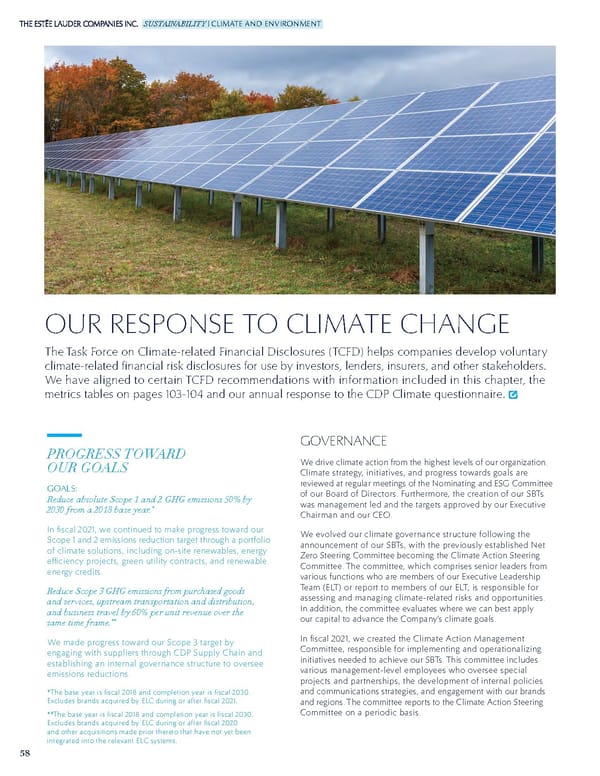58 SUSTAINABILITY CLIMATE AND ENVIRONMENT GOVERNANCE We drive climate action from the highest levels of our organization. Climate strategy, initiatives, and progress towards goals are reviewed at regular meetings of the Nominating and ESG Committee of our Board of Directors. Furthermore, the creation of our SBTs was management led and the targets approved by our Executive Chairman and our CEO. We evolved our climate governance structure following the announcement of our SBTs, with the previously established Net Zero Steering Committee becoming the Climate Action Steering Committee. The committee, which comprises senior leaders from various functions who are members of our Executive Leadership Team (ELT) or report to members of our ELT, is responsible for assessing and managing climate-related risks and opportunities. In addition, the committee evaluates where we can best apply our capital to advance the Company’s climate goals. In fiscal 2021, we created the Climate Action Management Committee, responsible for implementing and operationalizing initiatives needed to achieve our SBTs. This committee includes various management-level employees who oversee special projects and partnerships, the development of internal policies and communications strategies, and engagement with our brands and regions. The committee reports to the Climate Action Steering Committee on a periodic basis. PROGRESS TOWARD OUR GOALS GOALS: Reduce absolute Scope 1 and 2 GHG emissions 50% by 2030 from a 2018 base year. * In fiscal 2021, we continued to make progress toward our Scope 1 and 2 emissions reduction target through a portfolio of climate solutions, including on-site renewables, energy efficiency projects, green utility contracts, and renewable energy credits. Reduce Scope 3 GHG emissions from purchased goods and services, upstream transportation and distribution, and business travel by 60% per unit revenue over the same time frame. ** We made progress toward our Scope 3 target by engaging with suppliers through CDP Supply Chain and establishing an internal governance structure to oversee emissions reductions. *The base year is fiscal 2018 and completion year is fiscal 2030. Excludes brands acquired by ELC during or after fiscal 2021. **The base year is fiscal 2018 and completion year is fiscal 2030. Excludes brands acquired by ELC during or after fiscal 2020 and other acquisitions made prior thereto that have not yet been integrated into the relevant ELC systems. OUR RESPONSE TO CLIMATE CHANGE The Task Force on Climate-related Financial Disclosures (TCFD) helps companies develop voluntary climate-related financial risk disclosures for use by investors, lenders, insurers, and other stakeholders. We have aligned to certain TCFD recommendations with information included in this chapter, the metrics tables on pages 103-104 and our annual response to the CDP Climate questionnaire.
 Estee Lauder Companies Sustainability Report Page 58 Page 60
Estee Lauder Companies Sustainability Report Page 58 Page 60